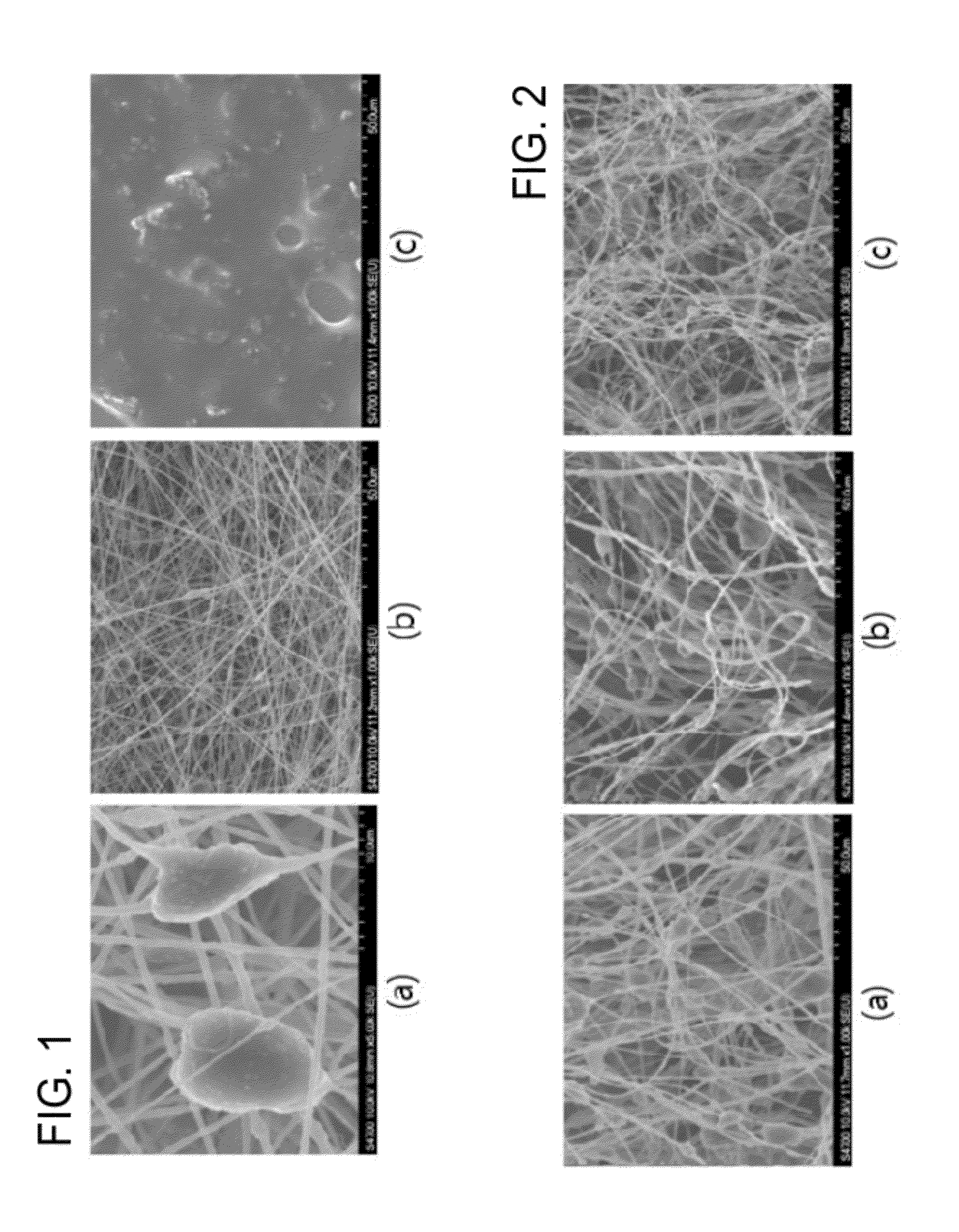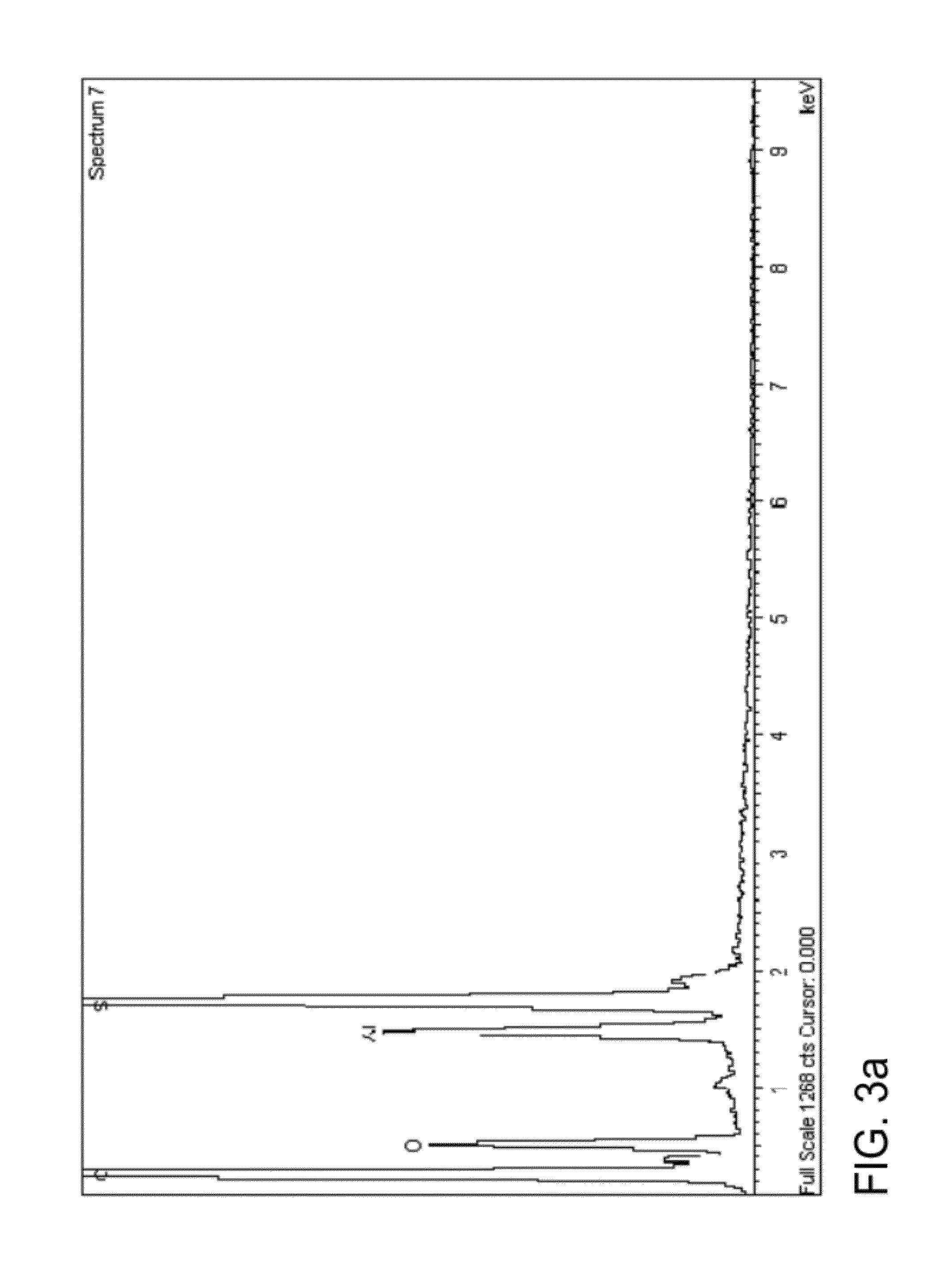Sheets including fibrous aerogel and method for producing the same
- Summary
- Abstract
- Description
- Claims
- Application Information
AI Technical Summary
Benefits of technology
Problems solved by technology
Method used
Image
Examples
example 1
[0052]30 ml of a commercial water glass solution was mixed with 20 ml of ethanol, which corresponds to ⅔ of the volume of the water glass solution, and 10 ml of water, which corresponds to ⅓ of the volume of the water glass solution, to prepare a wet gel. Gelling of the mixture was observed within 10 min after mixing. The surface of silica constituting the wet gel was hydrophilic. To 10 g of the wet gel were sequentially added 10 ml of propanol, 40 ml of hexane and 20 ml of trimethylchlorosilane. The resulting mixture was subjected to surface modification and solvent substitution at room temperature for 3 hr to obtain a hydrophobic silica gel whose surface was hydrophobically modified. 2.5 g of polymethyl methacrylate (PMMA) and 1 g of the hydrophobic silica gel, which corresponds to 40% of the weight of the polymer, were added to 10 ml of N,N-dimethylformamide (DMF). After mixing for 1 day, the solution of the polymer and the hydrophobic gel was used as a electrospinning solution f...
example 2
[0056]A polymer solution was prepared in the same manner as in Example 1, except that polyacrylonitrile (PAN) was used instead of polymethyl methacrylate. 10 g of the hydrophobic gel and 15.1 g of polyacrylonitrile (PAN) were added to and mixed with 100 ml of N,N-dimethylformamide (DMF) for 1 day. The weight of the hydrophobic gel corresponds to 66% that of the polymer and the weight of the PAN polymer corresponds to 13% that of the polymer solution. After mixing, the solution of the polymer and the hydrophobic gel was used as a electrospinning solution for making a fiber web.
[0057]The electrospinning solution was electrospun using a vertical type electrospinning apparatus. In the electrospinning apparatus, the distance between a spinning nozzle and a current collector was fixed to 20 cm, the voltage was set to 40 kV, and the electrospinning solution was supplied at a rate of 65 ml / hr. As a result of the spinning under an electric field, a thin sheet in the form of a fiber web was p...
example 2-1
Comparison of Characteristics of Sheets Produced by Mixing Polymer (PAN) and Hydrophobic Gel in Different Ratios
[0059]Sheets were produced in the same manner as in Example 2, except that the mixing ratio of polyacrylonitrile to the hydrophobic gel varied from 30% (S / P=0.3 in FIGS. 4a to 4d) to a maximum of 180% (S / P=1.8 in FIGS. 4a to 4d). 1.1 g of polyacrylonitrile and the hydrophobic gel were mixed with 10 ml of N,N-dimethylformamide to prepare spinning solutions. The hydrophobic gel was used in different amounts (0.3 g, 1 g, 1.5 g and 2 g). The spinning solutions were electrospun to produce sheets. The sheets were dried in air at 100° C., 200° C. and 250° C. Images of the sheet after spinning and the sheets after drying at the different temperatures were taken by scanning electron microscopy and are shown in FIGS. 4a to 4d. The figures demonstrate that the flowability of the solutions increased and the amount of beads increased with increasing amount of the hydrophobic gel.
PUM
| Property | Measurement | Unit |
|---|---|---|
| Temperature | aaaaa | aaaaa |
| Temperature | aaaaa | aaaaa |
| Diameter | aaaaa | aaaaa |
Abstract
Description
Claims
Application Information
 Login to View More
Login to View More - R&D
- Intellectual Property
- Life Sciences
- Materials
- Tech Scout
- Unparalleled Data Quality
- Higher Quality Content
- 60% Fewer Hallucinations
Browse by: Latest US Patents, China's latest patents, Technical Efficacy Thesaurus, Application Domain, Technology Topic, Popular Technical Reports.
© 2025 PatSnap. All rights reserved.Legal|Privacy policy|Modern Slavery Act Transparency Statement|Sitemap|About US| Contact US: help@patsnap.com



